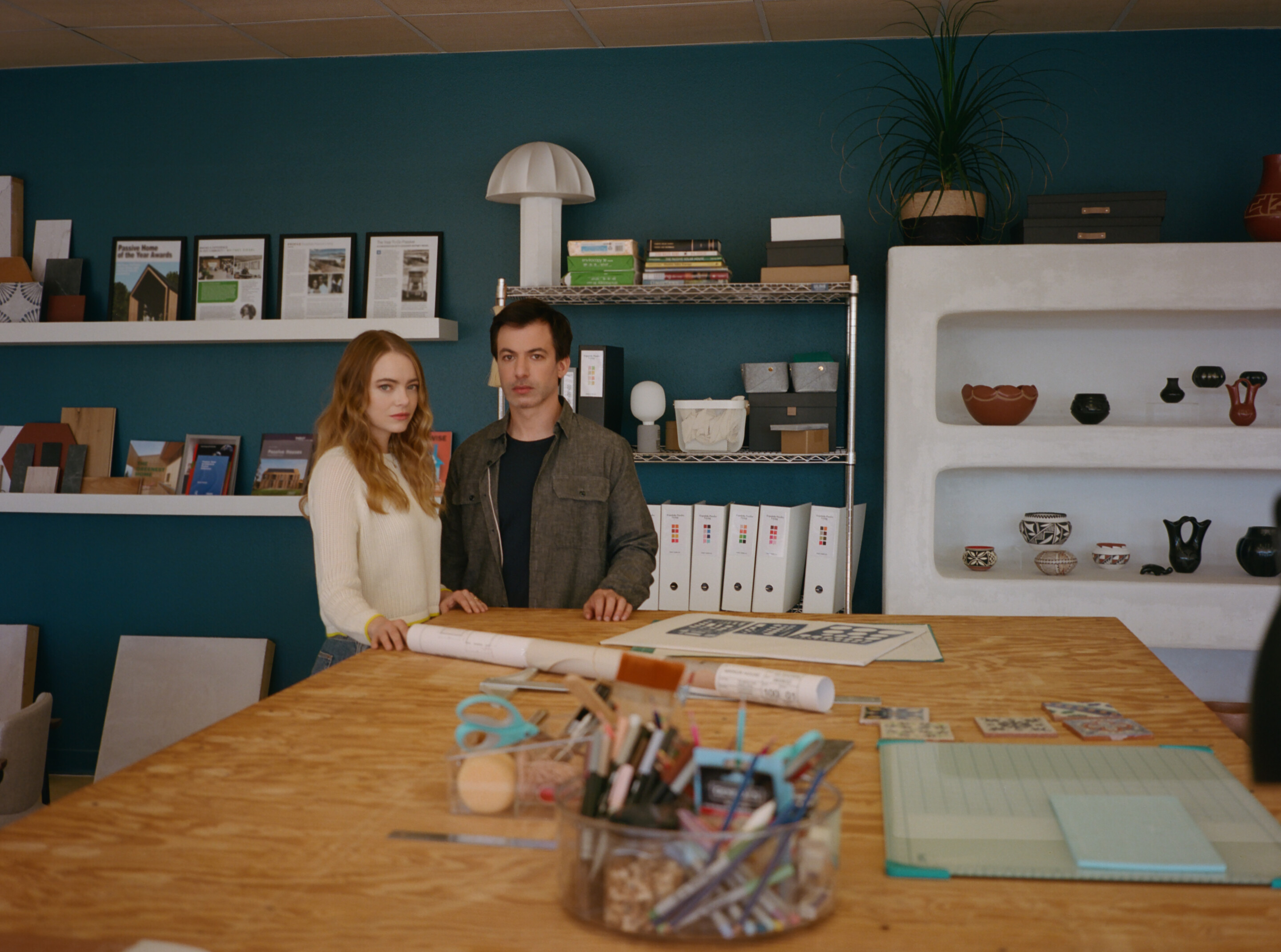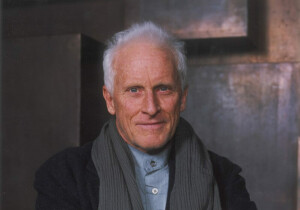The Curse follows newlyweds Whitney Spiegel (Emma Stone) and Asher Spiegel (Nathan Fielder) on their journey to transform their “hometown” of Española, New Mexico, near Santa Fe, into a fully carbon-neutral city using sustainable architecture. Whitney handles the design and Asher handles the business; together, they make up the Española Passive Living Office. For their HGTV show Fliplanthropy, producer Dougie Schecter (Benny Safdie) documents them reading land acknowledgments on construction sites, subsidizing rent for Latine families under the threat of displacement, and gifting expensive Indigenous ceramics that they bought at bulk discounts. In an attempt to stage a pandering reality television moment, Dougie encourages Asher to offer money to Nala (Hikmah Warsame), a young girl selling drinks alongside her sister Hani (Dahabo Ahmed) and father Abshir (Barkhad Abdi). When Asher distastefully returns to retract his offer, Nala avows: “I curse you.”
Created by Fielder and Safdie for Paramount+ with Showtime, The Curse is a show within a show that tilts its audience to decipher their own mimetic realism. Home renovation shows are themselves nested within the broader category of the makeover subgenre within reality television: They build on the theory of self, popularized in 18th-century Romanticism, that asserts interiority must be excavated to validate one’s authenticity. The self is not simply revealed but must be actively constructed as a reflexive project using all available media. Instead of tacit acceptance of material realities, one must instead exhaustively mobilize—“make real,” as Abshir cautions—their desires. Just as a program on plastic surgery is not quite about the physical body, The Curse merely uses the house as a vehicle to negotiate anxieties that arise from shifts in aesthetic, technological, and economic conditions.

The collapsed experience of interiority and desire concurs with several recent shows—from the luxury resorts of HBO’s The White Lotus to the billionaire bunkers of FX’s A Murder at the End of the World—but Fielder’s docu-comedy format permits more specificity. While the subgenre leaves much unseen (because HGTV does not care about reproducing reality as much as reproducing the semblance of a desired reality), The Curse resists masking the work of its production through the Charlie Kaufman–style mise en abyme. The Rehearsal, Fielder’s previous project, explored similar formulaic reality television tropes and their cultural repercussions at the individual scale. Now, he’s upscaling to the urban.
The Curse finds strength in its metanarrative by employing architecture as its central reflexive device. This heading is first established in the opening shot: The camera moves toward an open window as we hear ex-con Fernando Castillo (Christopher Calderon) talking about his struggle to find work as his sick mother faces eviction. As we get closer, the Spiegels chime in dulcet tones to offer rent subsidies and employment at their coffee shop—snapping sharply to a more tensioned scene as Asher calls for the film crew to reset the frame. The cultural progression of the window, originating as a simple void for light and ventilation, transforms into a technological operation simulating connection through division—transparency with desire—in the incorporation of glass. The Curse considers this as a material and figurative trope very seriously, with the home becoming a machine for viewing and making the self.

The show is consistently filtered through variegated “windows:” peepholes, doorways, windows, mirrors, phone screens, televisions, and most definitively through the ostentatious facades at the heart of the show. The Siegels’ net-zero homes are clad in reflective glass laminated with a photovoltaic profile and are fully insulated to avoid thermal bridging. (“Like a thermos!” Whitney repeats several times, with a forced bleached smile.)

The Passive House Society in Germany certified the project, but their representative made it clear that the mirrored exterior is not at all required. Whitney flinches when this is mentioned but quickly chimes in to maintain that eco-living can be achieved “without sacrificing design.” This subtle reaction, along with telling her housekeeper off-camera to clean up the smudges left by yet another bird that hit the facade (all while sporting a Greenpeace t-shirt) is the first crack in the foundation of her self-project. The titular curse serves as the plot trigger, but more importantly, the prism through which the characters are haunted by their desires. Nala later discloses that she got the idea from a “tiny curse” trend on TikTok, which conversely implies the presence of the inevitable “big” curse. Whitney’s tiny curse is an unhappy marriage, but her big curse is her generational privilege.
Her latter curse becomes her shield. She envelops her “invisible” homes with her desire to be perceived as different from her locally infamous, eviction-happy slumlord parents while simultaneously protecting the affordances provided through nepotism. Her mirrored houses “reflect the community.” Thus, she cannot be the villain; cut to her White Girl Tantrum about her exclusive ownership of the Native land that was bought for her at foreclosure auctions.
The absurdly delicate ecosystem of the passive house parallels that of her passive privilege. Her anxiety over contamination (scored by Daniel Lopatin, of Oneohtrix Point Never; and John Medeski, of Medeski Martin & Wood) rises equally under the threat of, god forbid, an air-conditioning unit, or her phone number being publicly connected to her parent’s “hell-on-earth” residential properties which exploit the working class. The air-tight envelope, a product of the modern mechanization of architectural space, becomes performative. Her desire for comfort in her complicity leads to a false sense of interior control. Its subsequent obfuscation of exterior impressions—thermal, social, or otherwise—only serves to exalt her self-image. For those who live in conditioned environments, the curse is everywhere except within themselves.
By aligning the fragility of her design with her designed image, The Curse questions the extent to which architects are making spaces or simply managing architecture’s image. For the most part, it succeeds in making architectural practice look clumsy in its ethical hypocrisies by avoiding differentiating being a designer from being a performer. As viewers have become more socially conscious, Fliplanthropy ’s HGTV network executives must configure the correct balance between attending to the adverse effects of an affordable housing crisis without drawing attention to the displacement caused by their productions—the priority is their neoliberal late-capitalist directives, something that architects can connect with all too well. We can talk about it, but we can’t look in the mirror too long. The formal and material characteristics of Whitney’s homes unconsciously reveal the effacement inherent to architecture and real estate under Western settler-colonial contexts, where exploitation begets exploitation.

Whitney’s didactic, faux-sentimental fiction runs so deep that she falls short of authentic engagement in any form. She believes in the reality television ethos that good citizens are made by granting permission to be observed but ultimately fails to coherently mesh—or even intellectually connect—her desires of moral upward mobility with her preconditions. Whitney’s ineptitude in pairing self-scrutiny with revision settles for the same ambivalence that allows her parents to thrive as unapologetic developers.
Asher’s tiny curse is his tiny package and his big curse is that Whitney thinks “[his] world is so tiny.” This scale relation appears to reflect on Asher’s masculinity but, as the transactional story of their marriage unfolds, it becomes clear that his malewife role is to play the sycophant to Whitney’s vacant colonial impulses. When she scolds him for behaving truthfully, she scolds herself. When he performs benevolently, she congratulates herself. She dislikes that he does not think about other people while knowing he only thinks about her (cue a Nathan Fielder cuck fetish sequence). In doing so, she corners herself in the implication that her world—the proverbial glass house she traps herself within—is what is tiny. He serves as a facsimile akin to the homes to reconcile her moral incongruencies.
Asher claims that there are no winners and losers of “the g-word” (gentrification) while playing a losing game himself. His cognizance of this flickers. Sometimes it’s inconspicuous, as when he’s belting out lyrics from “Hell Yeah” by Dead Prez (he’s just a “white boy in the wrong place at the right time”), but sometimes the foundation is shakier: I assume that Asher does not come from money based on the moments in which Whitney is most affronted by his continual blankness. He does not know how to interact with fancy pottery or understand that the perfect buyer is worth the fiscal loss. He only knows how to deflect at her defense. Yet when he drives Whitney to her tipping point (in their shiny black Tesla nonetheless), she has no issues discarding him. Once he has nothing left to offer, he can only cling to the remnants of his desire to belong in her conditioned world.
The Curse is a timely unraveling of liberal fallacies. It also traffics in performative allyship, both in and out of architecture. If Asher is willingly deferential, Whitney’s “friend” Cara Durand (Nizhonniya Austin), a Picuris Pueblo artist, is reluctantly so. Cara’s tiny and big curses are the same: She is painfully aware of the ways in which she exists for white consumption. Whitney condescendingly describes how “stifling” it must be for Cara to exclusively produce work based on her Native identity to qualify for grants. She can choose the facade she wears but Cara does not have that luxury. Whitney takes advantage of this, parading Cara around as an object to make herself glimmer, and sometimes more flagrantly puppeteering Cara to acquiesce to her self-project without being challenged. To Whitney, Cara is a cutout figure in the rendering of her conditioned world. Whitney’s desperate need to be validated by Cara is only superseded by her demand to have everything; she cannibalizes Cara’s emotions—and those of all marginalized bodies within the show—to propel her design narrative.

To this effect, Whitney begins to consider her homes as art. However, in doing so, it inadvertently positions the homes as a project driven entirely by vanity because, unlike Cara, Whitney has no point of view. She paradoxically refers to her homes as “invisible” to semantically mask her negative impact on the community, and the sanitized exterior appropriately aligns with the algorithmically generated coziness of the interior. Everything is built-in to enforce a rigid domestic manual designed by someone granted the privilege of choice. Despite the editorial packaging of responding to local histories and ecologies, the bespoke homes made entirely in her image are hollow and untethered from their intent because no one wants (or has the financial means) to buy them. In one of the more satisfying moments of the show, Cara suggests that it does not matter whether these machinations are intentional—the violence is all the same. Fliplanthropy will get picked up, land values will rise, and the network—and architects alike—will be unable to absolve their guilt nor the guilt of the viewer at home.
The Curse simultaneously captures architecture as a performance of desire and a practice in constant friction with its complicity with moral and ecological atrocities. The social mission of architecture has been deformed as a tool of capital, and its so-called radical endeavors are swallowed by deluded notions of ideological fulfillment. Between cursed characterizations of the ambivalent, the servile, and the consumed—or a combination of the three—The Curse employs Romantic irony when depicting a designer in their search to find coherence in their discontinuities. It’s a show that will amass many analyses some of which have to wait for its fast-approaching finale.
The Curse is not so much a thermos as it is a pressure cooker; it calibrates its audience to desperately search for a pressure-relief valve and in doing so realize their part in choosing—being able to choose—to look away.
Samiha Meem is currently a visiting assistant professor at the Knowlton School of Architecture at Ohio State University. As their 2023–24 LeFevre Fellow, she is pursuing a research-based project on pop media machines and “girlrooms” to be exhibited next year.











